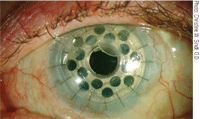 Contact lenses have been used in therapeutic application for decades; the first use dates back to Celsus, a second-century Greek philosopher, who used a honey-soaked linen cloth placed in the inferior fornix.1 Today, we have better options.
Contact lenses have been used in therapeutic application for decades; the first use dates back to Celsus, a second-century Greek philosopher, who used a honey-soaked linen cloth placed in the inferior fornix.1 Today, we have better options.
We employ contact lenses for several therapeutic purposes: reduction of pain associated with corneal epithelial defects and abnormalities; healing of corneal defects; protection of the cornea from drying and mechanical trauma; sealing of corneal wounds or perforations by splinting, thereby restoring the anterior chamber; and optical enhancement by providing a smooth anterior/air-cornea interface over corneal surfaces that are made irregular by trauma, surgery or disease.1-3
In most cases, bandage lenses protect the eye from external insult, isolate the ocular surface from friction during the blink and allow medication to easily be instilled. This is an important requirement when using a lens for keratoprostheses.4 A contact lens is highly protective against evaporative damage to the corneal surface around the device and, if a cosmetic/tinted lens is used, can even shield the eye from light.2
The Boston Keratoprosthesis

The Boston keratoprothesis is defined as an “artificial cornea.”
The Boston keratoprosthesis is a novel device for restoring vision; it is defined as “an artificial cornea” that can be used for patients with severe corneal opacity where corneal transplantation has failed for one reason or another.2,5,6 World-renowned corneal specialist Claes H. Dohlman, M.D., Ph.D., began developing the device in the 1960s.4
The keratoprosthesis can be used when standard corneal grafting has failed or when such a procedure would likely not succeed. It is made of clear plastic with excellent tissue tolerance and optical properties. When fully assembled, its components include a collar-shaped button for attachment to the recipient cornea.5,6 The device is inserted into a corneal graft and sutured into the patient’s cornea, similar to a traditional transplant.
For long-term maintenance, the patient will require the use of a therapeutic lens—a continuously worn soft lens along with daily application of prophylactic antibiotics.5 Glaucoma and anti-inflammatory medications are frequently required when dealing with diseased eyes. A cosmetic (colored) contact lens can be used to closely match the iris color of the other eye.5 The prosthetic device is known for its stability and safety; as long as the rest of the visual system remains unchanged, the device should provide excellent vision.5,6
Keep in mind that when fitting any therapeutic lens following corneal surgery, special considerations require very close monitoring for infection and the use of materials that provide complete corneal coverage and high oxygen flux. Regular lens replacement is also necessary.
Contact lenses have served the ophthalmic community admirably over the years. Fitting lenses following keratoprosthesis surgery for a surrounding protective effect is just another use, illustrating the utility of the soft lens material. Celsus would be proud of the advances made since his first application.
1. Chan W, Weissman BA. Therapeutic contact lenses. In: Bennett ES, Weissman BA, eds. Clinical Contact Lens Practice. Philadelphia: Lippincott, Williams & Wilkins. 2005:549-73.
2. Dohlman CH, Dudenhoefer EJ, Khan BF, Morneault S. Protection of the ocular surface after keratoprosthesis surgery: The role of soft contact lenses. CLAO J. 2002 Apr;28(2):72-4.
3. McMahon TT, Szczotka-Flynn LB. Contact lens applications for ocular trauma, disease and surgery. In: Bennett ES and Weissman BA, eds. Clinical Contact Lens Practice. Philadelphia: Lippincott, Williams & Wilkins. 2005:549-73.
4. Trattler W. Bandage contact lenses. Eyecare Educators. Available at:
www.eyecareeducators.com/site/bandage_contact_lenses.htm (accessed August 2011).
5. Artificial Cornea – The Boston Keratoprosthesis. Massachusetts Eye & Ear. Available at:
www.masseyeandear.org/specialties/ophthalmology/cornea-and-refractive-surgery/keratoprosthesis (accessed August 2011).
6. Sayegh R, Diaz LA, Vargas-Martín F, et al. Optical functional properties of the Boston Keratoprosthesis. Invest Ophthalmol Vis Sci. 2010 Feb;51(2):857-63.


